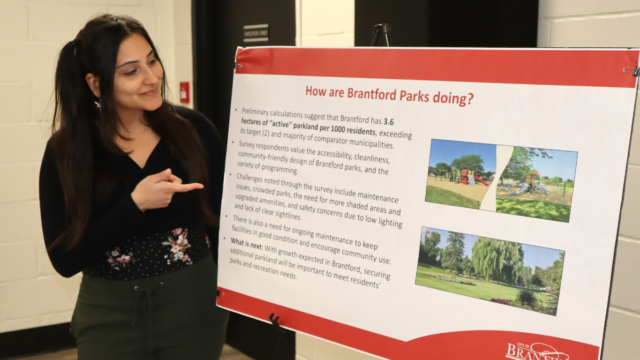The City of Brantford is making strides toward updating its Parks and Recreation Master Plan, emphasizing community engagement to ensure recreational offerings meet the city’s growing needs.
On Monday evening, Gagan Batra, Manager of Business Support and Sustainability for the City of Brantford, spoke with BrantBlog at the Woodman Park Community Centre during the final open house session.
The updates to the Master Plan, which include the city’s first-ever sports fields and courts strategy, are designed to guide the future of sports and recreation in Brantford. These updates also address challenges stemming from recent provincial policy changes affecting funding for parks, while providing direction on utilizing new lands.
Batra explained that the engagement sessions were key in presenting draft recommendations and gathering community feedback. “We’re making it clear to the public that these recommendations are not finalized,” she said. “We’re still looking for feedback on whether residents agree with our proposals, whether we need to add anything, or if there are concerns about specific recommendations. If we hear strong opposition to something, we’ll revisit and adjust accordingly.”
Among the priorities emerging from the strategy is the need for an indoor turf facility to enable year-round sports, which Batra identified as a critical gap in Brantford. “Right now, outdoor sports like soccer and baseball come to a halt in winter because we don’t have indoor turf fields. Our study showed we’re one of the few cities without such a facility, so this is our top priority,” she noted.
Additional recommendations include leveraging technology to track field usage, even for facilities without booking systems, and addressing imbalances in the demand for baseball diamonds by enhancing underutilized fields with features like lighting and parking.
Provincial policies, particularly Bill 23, have created significant challenges for parks funding. “The Build More Homes Faster Act has cut in half the parkland dedication and cash-in-lieu funding we receive from developers,” Batra explained. “This limits the amount of park space we can build and the funds available for development. To adapt, we’re prioritizing land over cash contributions and exploring incentives to encourage developers to dedicate more parkland than the minimum required.”
The timeline for finalizing the updated Master Plan involves presenting the recommendations to City Council in March or April 2025. If approved, short-term initiatives, such as equipping gyms with multipurpose spaces and implementing technology to monitor usage, could begin by the end of the year. Larger projects, like the indoor turf facility, would take longer, potentially spanning several years.
Batra stressed the importance of ongoing community involvement. “Even after the plan is finalized, we encourage residents to continue sharing feedback. It’s crucial for us to know what the community needs and how we can improve.”
The City’s commitment to public input reflects its goal of creating a comprehensive and responsive Parks and Recreation Master Plan, ensuring equitable access to recreational facilities for all residents.


































